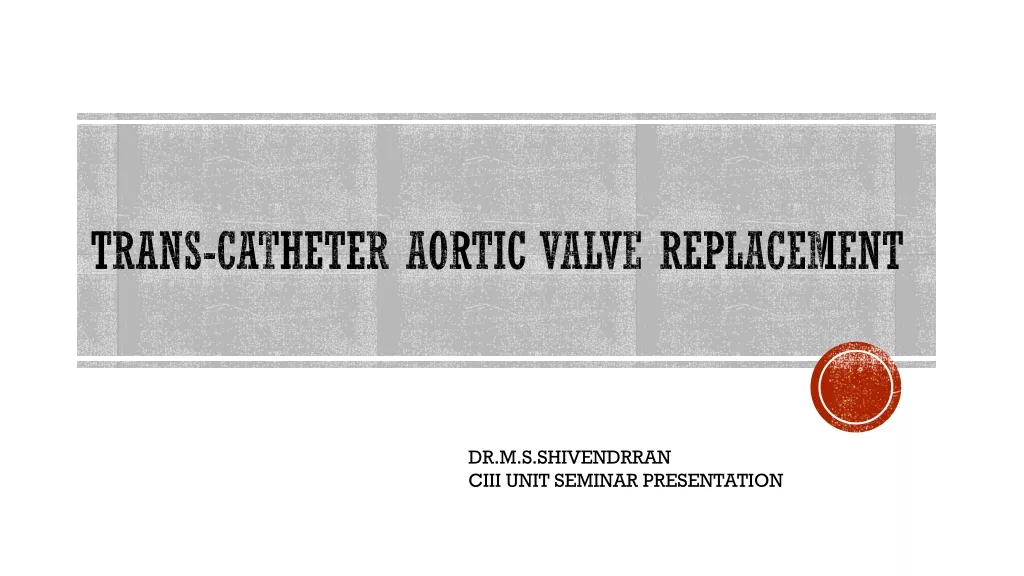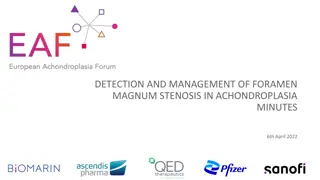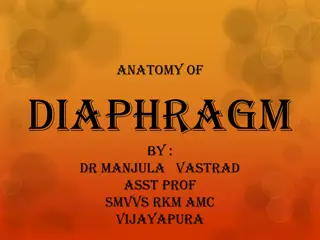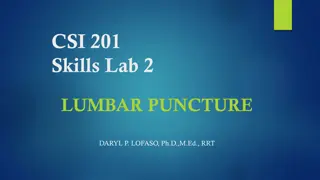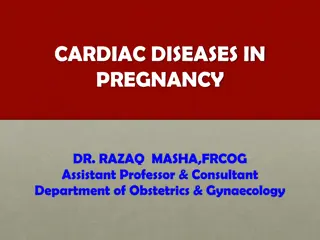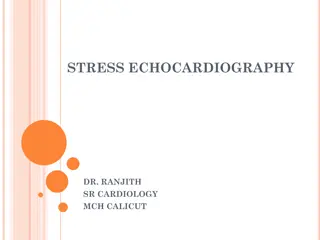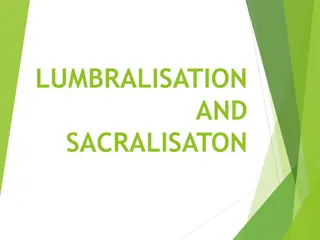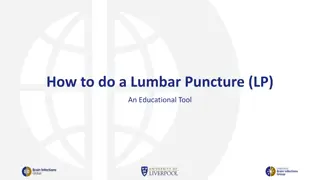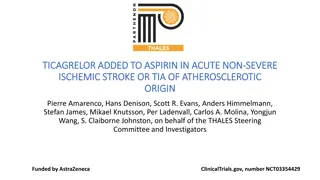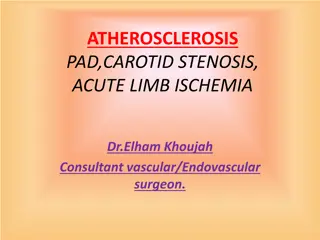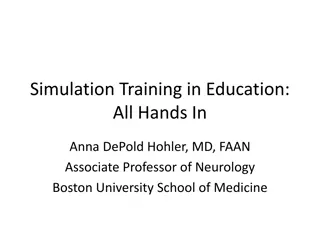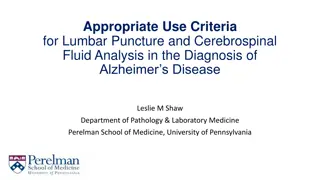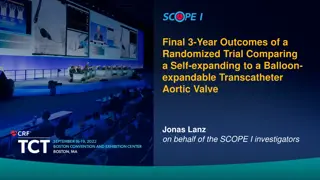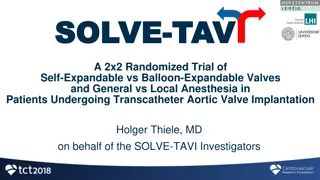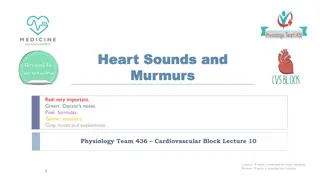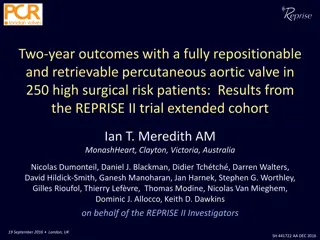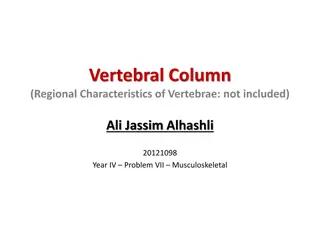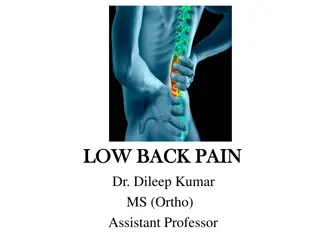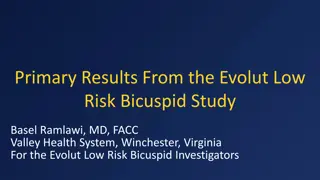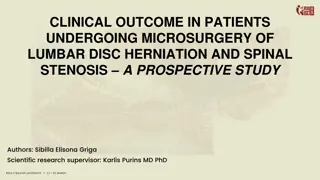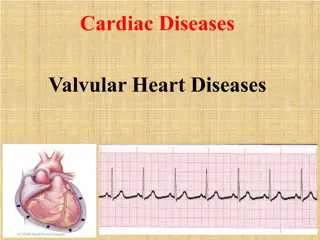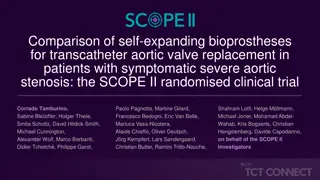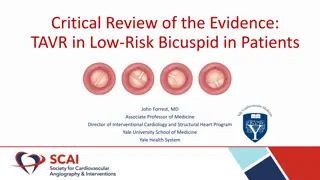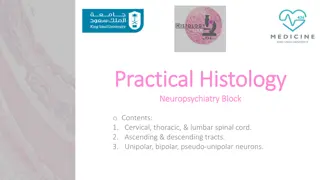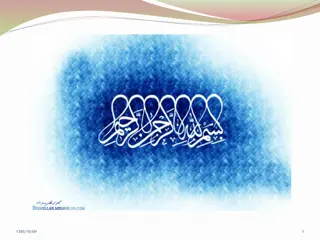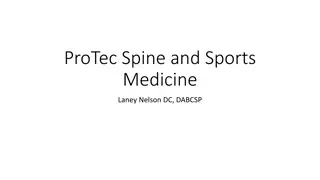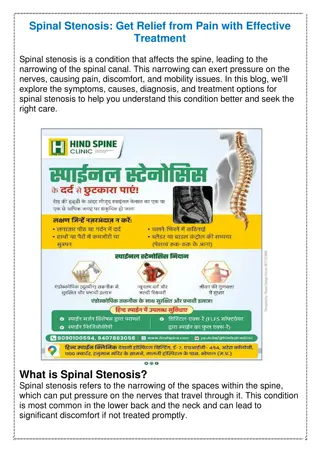Advances in Trans-Catheter Aortic Valve Replacement: A Comprehensive Review
This presentation explores the evolution of Trans-Catheter Aortic Valve Replacement (TAVR), highlighting historical milestones, anatomical considerations, the role of Balloon Aortic Valvuloplasty, current guidelines, the need for TAVI, and a notable case study by Dr. Cribier. The content discusses t
2 views • 85 slides
Understanding Hydrocollator Packs for Moist Heat Therapy
Hydrocollator packs are a form of superficial heat modality that utilize moist heat to transfer energy to the skin through conduction. These packs, filled with silica gel like bentonite, provide soothing heat for 30-40 minutes when heated in a hydrocollator unit. They come in various sizes and shape
8 views • 11 slides
Understanding Coronary Artery Bypass Graft (CABG) in Adult Nursing
Coronary Artery Bypass Graft (CABG) is a surgical procedure where a blood vessel from another part of the body is grafted onto an occluded coronary artery to bypass blockages. This procedure is less common in women compared to men and is typically indicated for severe coronary artery disease. It is
5 views • 15 slides
Management of Foramen Magnum Stenosis in Achondroplasia Workshop Overview
Workshop on the detection and management of foramen magnum stenosis in individuals with achondroplasia took place on 6th April 2022. The event focused on challenges, screening protocols, intervention indicators, decision-making processes, and management strategies. Key outcomes include reaching an a
0 views • 11 slides
Anatomy of the Diaphragm: Structure, Function, and Clinical Relevance
The diaphragm, a key muscle of respiration, separates the thoracic and abdominal cavities and plays a crucial role in breathing. This dome-shaped musculofibrous partition originates from various structures such as the xiphoid process, lower ribs, and lumbar vertebrae. Its actions are essential for t
1 views • 29 slides
Lumbar Puncture Procedure Overview
Understand the indications and contraindications, checklist, equipment required, needle passage layers, consent procedures, CSF testing, and key steps like patient positioning for a lumbar puncture. Learn about obtaining CSF, administering medications, measuring ICP, diagnosing CNS infections, and m
0 views • 13 slides
Otitis Externa: Overview, Risk Factors, and Treatment
Otitis externa, also known as swimmer's ear, is an inflammation of the external auditory canal. It can be acute or chronic and is common among individuals aged 7-14 years. The main causative organisms include Pseudomonas aeruginosa and Staphylococcus aureus. Risk factors include swimming in pools, h
0 views • 10 slides
Cardiac Diseases in Pregnancy: Implications and Management
Normal pregnancy induces significant physiologic changes in the cardiovascular system, which can impact women with pre-existing cardiac diseases. Understanding the New York Heart Association classification scheme is crucial for assessing symptomatology during pregnancy. Rheumatic Heart Disease, part
0 views • 12 slides
Understanding Post-Dural Puncture Headache in Children
Post-dural puncture headache (PDPH) is a common complication following lumbar puncture, characterized by a positional headache that worsens when upright and improves when lying flat. This article discusses the epidemiology, etiology, diagnosis, risk factors, management, and treatment of PDPH in chil
0 views • 30 slides
Neonatal Vomiting: Causes, Diagnosis, and Differential Diagnosis
Neonatal vomiting can be a concern when presenting with bile-stained or blood-stained vomit, projectile vomiting, or associated with weight loss and failure to grow. Various non-surgical and surgical conditions like Pyloric Stenosis can lead to vomiting in neonates. Common causes include Mid-gut vol
0 views • 16 slides
Comprehensive Guide to Stress Echocardiography in Cardiology Practice
Stress echocardiography is a valuable tool in diagnosing and managing coronary artery disease, valvular heart disease, and assessing heart function. This imaging technique helps in detecting flow-limiting stenosis, understanding the ischemic cascade, and evaluating cardiac function during stress. Va
0 views • 49 slides
Understanding Lumbarisation and Sacralisation in Human Spine
The human spine comprises the cervical, thoracic, lumbar, sacral, and coccyx vertebrae. Lumbarisation refers to the non-fusion of the uppermost sacral segment, while sacralisation involves fusion of the fifth lumbar vertebra with the sacrum. Lumbarisation can cause issues such as back pain, inflamma
0 views • 14 slides
ACST-2 Trial: Stenting vs. Surgery for Carotid Artery Stenosis
ACST-2 is a randomized trial comparing carotid artery stenting (CAS) versus carotid artery surgery (CEA) in asymptomatic patients with severe carotid stenosis. The trial, published in The Lancet in August 2021, involved 3625 patients. While surgery has been shown to reduce stroke rates, modern medic
0 views • 19 slides
Lumbar Puncture (LP) Educational Tool Overview
This educational tool provides information on how to perform a lumbar puncture (LP) for brain infections. It covers learning objectives, contraindications, and steps involved in the procedure. The content includes visuals and notes to enhance understanding and adaptation.
0 views • 26 slides
Ticagrelor Added to Aspirin in Acute Non-Severe Ischemic Stroke or TIA of Atherosclerotic Origin
Among patients with transient ischemic attack (TIA) or minor ischemic strokes, adding ticagrelor to aspirin has shown superior efficacy in preventing stroke or death, particularly in those with ipsilateral atherosclerotic stenosis. The THALES trial demonstrated that ticagrelor added to aspirin was m
0 views • 14 slides
Understanding Atherosclerosis, Peripheral Artery Disease, and Carotid Stenosis
This informative content details the histo-anatomy of blood vessels, pathophysiology of atherosclerosis, peripheral ischemia, and carotid artery disease. It covers the definition, risk factors, and processes involved in atherosclerosis, including endothelial cell function, blood flow dynamics, and f
3 views • 24 slides
Confusion and Stroke: A Challenging Case Presentation in the Emergency Department
A patient with a history of cerebral aneurysm presented to the Emergency Department with confusion and hiccups. Despite initial stability, imaging revealed findings suggestive of a possible stroke. Further studies including cEEG and lumbar puncture were performed. The MRI findings indicated restrict
0 views • 11 slides
Lumbar Puncture: Procedure, Complications, and Clinical Applications
Lumbar puncture, also known as LP, is an invasive procedure used to obtain cerebrospinal fluid (CSF) for diagnostic and therapeutic purposes. This procedure has a long history dating back to ancient times, with modern techniques developed in the late 19th century by Heinrich Quincke. LP is crucial f
2 views • 11 slides
Lumbar Puncture: Indications, Contraindications, and Post-procedure Considerations
Lumbar puncture is a medical procedure involving the insertion of a needle into the spinal subarachnoid space to collect cerebrospinal fluid for diagnostic or therapeutic purposes. Indications for performing a lumbar puncture include suspicion of meningitis, subarachnoid hemorrhage, CNS diseases lik
0 views • 17 slides
Simulation Training in Education: Enhancing Learning Through Hands-On Simulation
Hands-on simulation training in education provides students with valuable learning experiences by increasing self-reported knowledge and technical proficiency. Simulations help improve students' knowledge, experience, and comfort with challenging procedures in a lower-risk environment, leading to en
0 views • 13 slides
Appropriate Use Criteria for Lumbar Puncture in Alzheimer's Disease Diagnosis
Clinicians traditionally diagnose Alzheimer's Disease (AD) based on clinical criteria, but cerebrospinal fluid (CSF) AD biomarkers offer more reliable detection earlier in the disease course. This article discusses the criteria for lumbar puncture and CSF analysis in the diagnosis of AD, highlightin
0 views • 18 slides
Understanding Spinal Canal Stenosis: Causes, Symptoms, and Classification
Spinal canal stenosis is the abnormal narrowing of the spinal canal or intervertebral foramina, leading to compression of nerves and blood vessels. It can result in symptoms such as radiculopathy, claudication, myelopathy, and more. Cervical stenosis presents with arm pain and weakness, while lumbar
0 views • 18 slides
3-Year Outcomes of a Randomized Trial Comparing a Self-expanding to a Balloon-expandable Transcatheter Aortic Valve
Investigating the long-term effects of two transcatheter aortic valve systems in patients with severe aortic stenosis, this study follows 739 participants over a 3-year period. The trial compares the ACURATE neo and SAPIEN 3 devices, focusing on early safety and clinical efficacy at 30 days with fol
0 views • 26 slides
Comparison of Valve Types and Anesthesia Strategies in Transcatheter Aortic Valve Implantation
In the SOLVE-TAVI trial, patients undergoing transcatheter aortic valve implantation were randomized to receive either self-expandable or balloon-expandable valves under general or local anesthesia. The study aims to compare the effectiveness and safety of different valve types and anesthesia approa
0 views • 27 slides
Challenges and Techniques in Native RVOT Stenting for TOF+PS Patients
Native RVOT stenting in TOF+PS patients can be challenging due to anatomical complexities like short infundibulum and VSD. Different equipment and techniques are used for crossing tricuspid and pulmonary valves and delivering the stent. Dilating the pulmonary valve and addressing residual stenosis a
0 views • 22 slides
Understanding Heart Sounds and Murmurs in Cardiovascular Physiology
This detailed lecture covers the basics of normal and abnormal heart sounds, stethoscope placement, cardiac auscultation, and the physiological significance of heart murmurs. It explains the causes, descriptions, and grading of abnormal heart sounds, along with specific conditions like aortic stenos
0 views • 26 slides
Two-Year Outcomes with Fully Repositionable Aortic Valve in High Surgical Risk Patients
The REPRISE II trial extended cohort evaluated the Lotus Valve System's safety and performance in symptomatic patients with severe aortic stenosis at high risk for surgical valve replacement. This prospective, single-arm study assessed the valve system's effectiveness through various follow-ups and
0 views • 19 slides
Understanding the Vertebral Column and Abnormal Curvatures
The vertebral column, extending from the cranium to the coccyx, plays vital roles in protecting the spinal cord, providing support, and facilitating movement. It consists of 33 vertebrae arranged in 5 regions, each with specific functions and characteristics. The column's curvatures, including cervi
0 views • 12 slides
Understanding Low Back Pain: Causes, Epidemiology, and Management
Low back pain is a prevalent issue affecting adults globally, with lumbar disc disease and poor posture being significant contributors. This condition can result from various factors, leading to discomfort in the lower back region. Understanding the epidemiology, common and uncommon causes, as well
0 views • 61 slides
Detection and Management of Foramen Magnum Stenosis in Achondroplasia Workshop
The workshop focused on understanding challenges and implications of foramen magnum stenosis in individuals with achondroplasia. It aimed to review protocols for screening infants, evaluate intervention indicators, and reach a consensus on optimal detection and decision-making processes for decompre
0 views • 11 slides
Evolut Low Risk Bicuspid Study Analysis
This study aims to evaluate the safety and efficacy of transcatheter aortic valve replacement (TAVR) in low-risk patients with bicuspid aortic valve stenosis. TAVR with Evolut valves has shown promising results in tricuspid aortic stenosis, but data on bicuspid cases are lacking. The participating s
0 views • 27 slides
Gait Device Selection for Children with Lumbar Level Myelomeningocele
This presentation discusses the considerations and choices of gait devices for children with lumbar level myelomeningocele. It covers the specific needs of pediatric patients, benefits and drawbacks of various devices, funding requirements, and clinical application through case studies. The material
0 views • 31 slides
Clinical Outcomes in Microsurgery for Lumbar Disc Herniation: Prospective Study
This prospective study examined the clinical outcomes in patients undergoing microsurgery for lumbar disc herniation and spinal stenosis. The study evaluated the effectiveness of surgical intervention using the Oswestry Disability Index (ODI) and Numeric Rating Scale (NRS) questionnaires preoperativ
0 views • 13 slides
Understanding Mitral Stenosis: Causes, Symptoms, and Pathophysiology
Mitral stenosis is a valvular heart disease characterized by narrowing of the mitral valve orifice, leading to decreased blood flow and various complications. Rheumatic fever is a common cause, with thickening and calcification of valve tissue leading to pulmonary hypertension and heart failure. Exp
0 views • 31 slides
Comparison of Self-Expanding Bioprostheses in Transcatheter Aortic Valve Replacement
The SCOPE II randomized clinical trial compared the early and mid-term performance of the ACURATE neo and CoreValve Evolut self-expanding bioprostheses for transcatheter aortic valve replacement in patients with severe aortic stenosis. The study devices differed in features such as expansion, recapt
0 views • 24 slides
Critical Review of TAVR in Low-Risk Bicuspid Patients
TAVR has shown promising outcomes in tricuspid aortic stenosis but has not been extensively studied in low-risk bicuspid patients. The Low Risk Bicuspid Trial aims to evaluate the procedural and short-term outcomes of TAVR in this patient population through a prospective study involving 25 centers.
0 views • 21 slides
Practical Histology: Spinal Cord Tracts and Neurons Overview
This practical histology guide covers the cervical, thoracic, and lumbar spinal cord segments, along with ascending and descending tracts, and pseudo-unipolar/unipolar neurons. It emphasizes key features such as the ventral and dorsal horns, gracile and cuneate tracts, and provides essential informa
1 views • 12 slides
Recognizing and Managing Meningitis in Children: Key Points and Procedures
Amidst images of diagnostic criteria and contraindications, this content discusses signs of meningitis in children, the importance of lumbar punctures, and contraindications for immediate LP procedures. It emphasizes key symptoms like nuchal rigidity, altered consciousness, and signs of increased IC
0 views • 41 slides
Understanding the Role of Multifidus Muscle in Spinal Health
Exploring the multifaceted role of the multifidus muscle in lumbar spine stability and control through histochemical studies and clinical comparisons. Insights into muscle changes with spinal conditions and the importance of maintaining its integrity for overall spinal health are discussed.
0 views • 26 slides
Spinal Stenosis - Hind Spine clinic
At Hind Spine Clinic, Bhopal, we specialize in treating spinal stenosis, a condition that can significantly impact daily life due to chronic pain and discomfort. With advanced and effective treatment options, our expert team is dedicated to helping p
3 views • 6 slides
